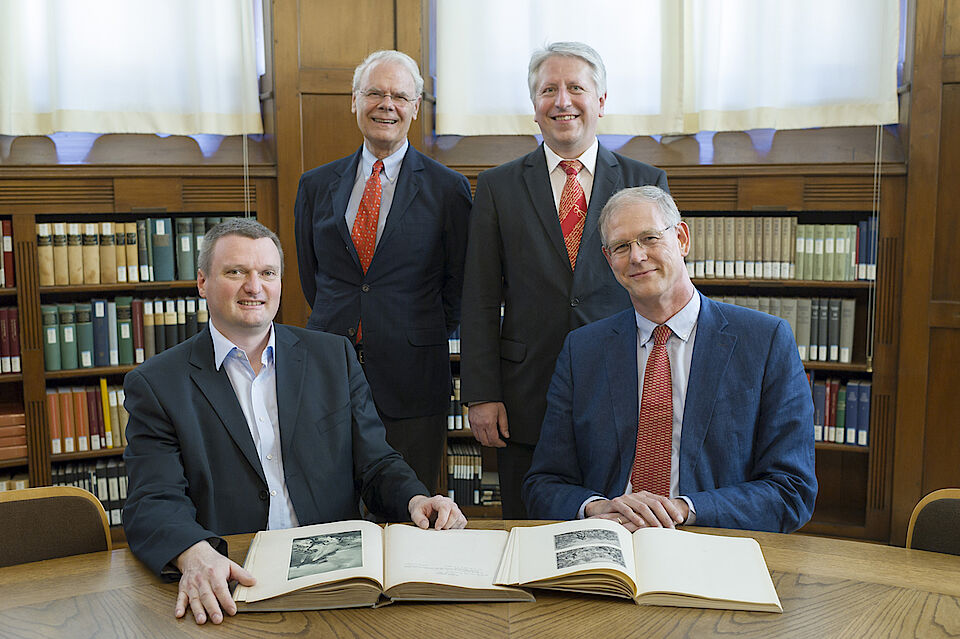Press Release 11.05.2012
New Sources for Research on Art Trade in the National Socialist Era scroll to top
International cooperation project republishes auction catalogs from the time between 1930 and 1945
For the first time, all auction catalogs published in Germany, Austria, and Switzerland between 1930 and 1945 are being recorded bibliographically, digitized and published online. The project is an international cooperative effort of the Art Library of the National Museums in Berlin, Heidelberg University Library, and the Getty Research Institute in Los Angeles. In future, researchers will be able to find all available information on sold works of art in a special research database. This represents a new source for research on art trade in the National Socialist era and on works of art whose owners were dispossessed and persecuted. The project entitled "German Sales 1930-1945. Art Works, Art Markets, and Cultural Policy" was presented to the public on 11 May 2012.
Auction catalogs are an important tool of provenance research. They are often the only possibility of identifying works of art or objects of cultural value that were taken from their rightful owners during the Nazi regime. Until now, researchers have not been able to fully access such catalogs from the time between 1930 and 1945. The catalogs are essential research sources, yet the copies that are available to libraries and research institutions are usually incomplete and inadequately edited, emphasise the project representatives. With their work, they want to contribute to closing that gap and thereby reconstruct the history of ownership of illegally appropriated works of art as well as to contribute to restoring the works to their rightful owners.
The Art Library of the National Museums in Berlin is preparing an extensive bibliography of all auction catalogs that were published between 1930 and 1945 in Germany, Austria, Switzerland, and the German-occupied territories. "Until now, we had no way of accessing these catalogs from a central location, because no institution in the world has ever collected them systematically", explains Dr. Joachim Brand, Associate Director of the Art Library. The bibliography lists all annotated copies, i.e. copies with handwritten comments. Information concerning prices, the names of consignors and buyers or of separately listed experts as well as the art historical evaluation of the piece or individual markings are of special importance.
Based on the catalogs listed in the bibliography, one catalog per auction is selected for digitisation. Besides the Berlin Art Library and Heidelberg University Library, 25 other institutions in Germany, Austria, and Switzerland are currently providing catalogs for this "virtual library". Dr. Veit Probst, Director of Heidelberg University Library, explains that an estimated 2,600 catalogs are digitised in Heidelberg using a time-tested process. 2,100 catalogs with approximately 150,000 pages have already been published online. The digitised catalogs can be searched with a detailed search mask or browsed according to the location of the auction house.
The two components of the "German Sales" project that are produced in Berlin and Heidelberg are compiled and elaborated in the Getty Provenance Index, the research database of the Getty Research Institute, explains Prof. Dr. Thomas W. Gaehtgens, Director of the Institute. The Art Library provides the bibliographical descriptions and information on annotated copies and their locations. Supplemented by notes on additional copies of the catalogs in American libraries, this information forms the "Sales Descriptions" database within the Provenance Index. The full texts of the digitised catalogs are imported from Heidelberg University Library and then edited. Where possible, the editors also research artists, buyer's names and prices, both in the catalogs and in other sources.
The findings of this project will provide new insights into the relationship between the art and cultural policy of the early 1930s and National Socialism. The project representatives also expect that their work will bring to light further information on the history of individual auction houses. In addition to facts on the founding and liquidation of auction houses, especially smaller, frequently unknown establishments, the project is expected to reveal changes of ownership, and thereby provide clues to possible compulsory acquisitions. The programmatic forewords of the auction catalogs represent another aspect of research that illustrates the buyers' interests and social background, and their aesthetic ideals.
The project "German Sales 1930-1945. Art Works, Art Markets, and Cultural Policy" was launched in November 2010 and is expected to be concluded by January 2013. The project is funded by the German Research Foundation (DFG), the National Endowment for the Humanities (NEH), and the Volkswagen Foundation. For more information, go to www.arthistoricum.net/en/subjects/thematic-portals/german-sales.
